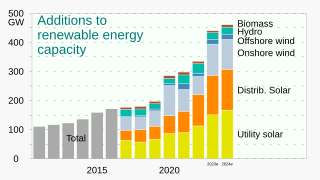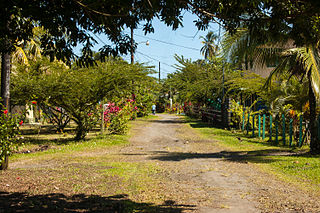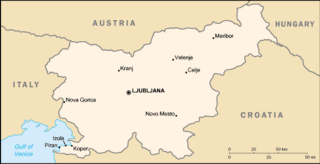Related Research Articles

Renewable energy is energy that is collected from renewable resources that are naturally replenished on a human timescale. It includes sources such as sunlight, wind, the movement of water, and geothermal heat. Although most renewable energy sources are sustainable, some are not. For example, some biomass sources are considered unsustainable at current rates of exploitation. Renewable energy often provides energy for electricity generation to a grid, air and water heating/cooling, and stand-alone power systems. About 20% of humans' global energy consumption is renewables, including almost 30% of electricity. About 7% of energy consumption is traditional biomass, but this is declining. Over 4% of energy consumption is heat energy from modern renewables, such as solar water heating, and over 6% electricity.

Energy development is the field of activities focused on obtaining sources of energy from natural resources. These activities include production of renewable, nuclear, and fossil fuel derived sources of energy, and for the recovery and reuse of energy that would otherwise be wasted. Energy conservation and efficiency measures reduce the demand for energy development, and can have benefits to society with improvements to environmental issues.

A low-carbon economy (LCE) or decarbonised economy is an economy based on energy sources that produce low levels of greenhouse gas (GHG) emissions. GHG emissions due to human activity are the dominant cause of observed climate change since the mid-20th century. Continued emission of greenhouse gases will cause long-lasting changes around the world, increasing the likelihood of severe, pervasive, and irreversible effects for people and ecosystems. Shifting to a low-carbon economy on a global scale could bring substantial benefits both for developed and developing countries. Many countries around the world are designing and implementing low-emission development strategies (LEDS). These strategies seek to achieve social, economic, and environmental development goals while reducing long-term greenhouse gas emissions and increasing resilience to the effects of climate change.

The production of renewable energy in Scotland is a topic that came to the fore in technical, economic, and political terms during the opening years of the 21st century. The natural resource base for renewable energy is high by European, and even global standards, with the most important potential sources being wind, wave, and tide. Renewables generate almost all of Scotland's electricity, mostly from the country's wind power.

Renewable energy commercialization involves the deployment of three generations of renewable energy technologies dating back more than 100 years. First-generation technologies, which are already mature and economically competitive, include biomass, hydroelectricity, geothermal power and heat. Second-generation technologies are market-ready and are being deployed at the present time; they include solar heating, photovoltaics, wind power, solar thermal power stations, and modern forms of bioenergy. Third-generation technologies require continued R&D efforts in order to make large contributions on a global scale and include advanced biomass gasification, hot-dry-rock geothermal power, and ocean energy. As of 2012, renewable energy accounts for about half of new nameplate electrical capacity installed and costs are continuing to fall.

The United States produced 5.2 billion metric tons of carbon dioxide equivalent greenhouse gas (GHG) emissions in 2020, the second largest in the world after greenhouse gas emissions by China and among the countries with the highest greenhouse gas emissions per person. In 2019 China is estimated to have emitted 27% of world GHG, followed by the United States with 11%, then India with 6.6%. In total the United States has emitted a quarter of world GHG, more than any other country. Annual emissions are over 15 tonnes per person and, amongst the top eight emitters, is the highest country by greenhouse gas emissions per person. Because coal-fired power stations are gradually shutting down, in the 2010s emissions from electricity generation fell to second place behind transportation which is now the largest single source. In 2020, 27% of the GHG emissions of the United States were from transportation, 25% from electricity, 24% from industry, 13% from commercial and residential buildings and 11% from agriculture. These greenhouse gas emissions are contributing to climate change in the United States, as well as worldwide.

According to preliminary data from the US Energy Information Administration, renewable energy accounted for about 12.6% of total primary energy consumption and about 19.8% of the domestically produced electricity in the United States in 2020.

The developing nations of Africa are popular locations for the application of renewable energy technology. Currently, many nations already have small-scale solar, wind, and geothermal devices in operation providing energy to urban and rural populations. These types of energy production are especially useful in remote locations because of the excessive cost of transporting electricity from large-scale power plants. The applications of renewable energy technology has the potential to alleviate many of the problems that face Africans every day, especially if done in a sustainable manner that prioritizes human rights.

Fossil fuel phase-out is the gradual reduction of the use and production of fossil fuels to zero. It is part of the ongoing renewable energy transition. Current efforts in fossil fuel phase-out involve replacing fossil fuels with sustainable energy sources in sectors such as transport and heating. Alternatives to fossil fuels include electrification, green hydrogen and biofuel. Phase-out policies include both demand-side and supply-side constraints. Whereas demand-side approaches seek to reduce fossil-fuel consumption, supply-side initiatives seek to constraint production to accelerate the pace of energy transition and reduction in emissions.
Green jobs are, according to the United Nations Environment Program, "work in agricultural, manufacturing, research and development (R&D), administrative, and service activities that contribute(s) substantially to preserving or restoring environmental quality. Specifically, but not exclusively, this includes jobs that help to protect ecosystems and biodiversity; reduce energy, materials, and water consumption through high efficiency strategies; de-carbonize the economy; and minimize or altogether avoid generation of all forms of waste and pollution." The environmental sector has the dual benefit of mitigating environmental challenges as well as helping economic growth.
Benin is a coastal country located in the Gulf of Guinea in Western Africa, which is a resource rich region. Energy in Benin has a diverse energy mix and takes several forms including: solar, wind, hydropower, biomass, fossil resources, and mineral resources. Out of this energy mix, about 60% of energy comes from biomass. Benin is also dependent on energy imports from Ghana and Côte d'Ivoire. While power plants and other energy facilities were built in the 1950s and 1960s, the lack of investment has led to deterioration over time. Similarly, its location in the baddie rich Gulf of Guinea has led to an attempt of oil production starting in the late 1980s. However, due to unprofitable operations, oil production halted in 1998.
Modern United States wind energy policy coincided with the beginning of modern wind industry of the United States, which began in the early 1980s with the arrival of utility-scale wind turbines in California at the Altamont Pass wind farm. Since then, the industry has had to endure the financial uncertainties caused by a highly fluctuating tax incentive program. Because these early wind projects were fueled by investment tax credits based on installation rather than performance, they were plagued with issues of low productivity and equipment reliability. Those investment tax credits expired in 1986, which forced investors to focus on improving the reliability and efficiency of their turbines. The 1990s saw rise to a new type of tax credit, the production tax credit, which propelled technological improvements to the wind turbine even further by encouraging investors to focus on electricity output rather than installation.

Green urbanism has been defined as the practice of creating communities beneficial to humans and the environment. According to Timothy Beatley, it is an attempt to shape more sustainable places, communities and lifestyles, and consume less of the world's resources. Urban areas are able to lay the groundwork of how environmentally integrated and sustainable city planning can both provide and improve environmental benefits on the local, national, and international levels. Green urbanism is interdisciplinary, combining the collaboration of landscape architects, engineers, urban planners, ecologists, transport planners, physicists, psychologists, sociologists, economists and other specialists in addition to architects and urban designers.

Total primary energy supply (TPES) in Slovenia was 6.80 Mtoe in 2019. In the same year, electricity production was 16.1 TWh, consumption was 14.9 TWh.
Vineyard Power Co-operative is "a community owned renewable energy co-operative based on the island of Martha's Vineyard, Massachusetts."

The energy transition is the ongoing process of replacing fossil fuels with low carbon energy sources. More generally, an energy transition is a significant structural change in an energy system regarding supply and consumption.

Protect Our Winters (POW) is a 501(c)(3) nonprofit that focuses its efforts on legislation regarding climate change. The nonprofit, created in 2007 by professional snowboarder Jeremy Jones, strives to turn outdoor enthusiasts into climate advocates. According to the group's mission statement, "Protect Our Winters leads a community of athletes, creative-pioneers and business leaders to achieve this mission." The organization's headquarters are located in Boulder, Colorado, United States.

Wind power in Virginia is in the early stages of development. In March 2015, Virginia became the first state in the United States to receive a wind energy research lease to build and operate offshore wind turbines in federal waters. As of 2019, Virginia had no utility scale wind farms.

Blue economy is a term in economics relating to the exploitation, preservation and regeneration of the marine environment. Its scope of interpretation varies among organizations. However, the term is generally used in the scope of International development when describing a sustainable development approach to coastal resources. This can include a wide range of economic sectors, from the more conventional fisheries, aquaculture, maritime transport, Coastal, marine and maritime tourism, or other traditional uses, to more emergent spaces such as coastal renewable energy, marine ecosystem services, seabed mining, and bioprospecting.
The desert-covered Kingdom of Saudi Arabia is the geographically largest country in the Middle East. Moreover, it accounts for 65% of the overall population of the GCC countries and 42% of its GDP. Saudi Arabia does not have a strong history in environmentalism. Thus, as the number of population increases and the industrial activity grows, environmental issues pose a real challenge to the country.
References
- ↑ http://www.offshorewindpartners.org Archived 2011-08-07 at the Wayback Machine
- ↑ "Clean Projects - Citizen Partnerships for Offshore Wind". www.theclean.org. Archived from the original on 2012-03-12.